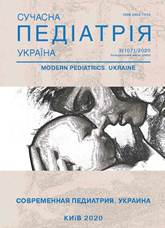Рeculiarities of changes in vital signs in children of different age groups with community-acquired pneumonia under the influence of high-frequency chest wall oscillation
Keywords:
pneumonia, children, vital signs, oxygen saturation, high&frequency chest wall oscillationAbstract
High-frequency chest wall oscillation (HFCWO) is a modern bronchodrainage method whose mechanism of action is aimed at improving the function of external respiration and restoring gas exchange in the lungs in children.Objective. To study the peculiarities of changes in vital indicators in children of different age groups with community-acquired pneumonia (CAP) under the influence of high-frequency chest oscillations.
Materials and methods. The dynamics of the vital signs were evaluated for 107 children aged 6 to 17 years with acute and uncomplicated course of САP, medium severity, average age — 11.73±0.53 years. The children were divided into the main group (MG) — 55 children who were assigned basic therapy (BT) with additional oscillation procedures and the control group (CG) — 52 children who received and only BT.
Results. We noticed a normalization of body temperature in both groups, comparing the vital signs. Using the oscillation procedures has a positive effect on systolic and diastolic arterial vise and heart rate without disrupting hemodynamics. There was a reliable recovery of in children with systolic and diastolic arterial vise from 22.43±0.43 (95% CI 11.05–32.95) to 18.29±0.29 (95% CI 7.85–28.15), and improvement of RR in children with CG from 22.3±0.53 (95% CI 11.56–34.44) to 19.21±0.23 (95% CI 8.34–29.66). It’s important to note a significant increase of SpO2 — 4.72% in MG compared to the CG of 2.34%, respectively.
Conclusions. The high efficiency of HFCWO in the treatment of MG’s children with CAP is confirmed by the reliable dynamics of vital signs, in particular, the increase of blood saturation indicates the restoration of the functioning of the respiratory tract.
The research was carried out in accordance with the principles of the Helsinki Declaration. The study protocol was approved by the Local Ethics Committee of an participating institution. The informed consent of the patient was obtained for conducting the studies.
No conflict of interest was declared by the authors.
References
Aryayev NL. (Editor) (2005). Detskaya pul'monologiya. Kyiv: Zdorov'ya: 608.
WHO. (2019). Pneumonia. Facts sheets (August 2019). https://www.who.int/news0room/fact0sheets/detail/pneumonia/
MOZ Ukrainy. (2005). Pro zatverdzhennia Protokoliv nadannia medychnoi dopomohy ditiam za spetsialnistiu dytiacha pulmonolohiia. Nakaz vid 13.01.2005 N18. https://zakon.rada.gov.ua/rada/show/v0018282-05
Bennett NJ. (2018). Pediatric Pneumonia: Pediatrics: General Medicine. Drugs&Diseases. https://emedicine.medscape.com/article/967822-overview/
Chakravorty I, Chahal K, Austin G. (2011). A pilot study of the impact of high-frequency chest wall oscillation in chronic obstructive pulmonary disease patients with mucus hypersecretion. Int J Chron Obstruct Pulmon Dis. 6: 693–699. https://doi.org/10.2147/COPD.S22896; PMid:22259246 PMCid:PMC3257955
Floyd J, Wu L, Hay Burgess D, Izadnegahdar R et al. (2015, Dec 3). Evaluating the impact of pulse oximetry on childhood pneumonia mortality in resource0poor settings. Nature.528(7580): 53–9. https://doi.org/10.1038/nature16043; PMid:26633766
Hooli S, Colbourn T, Lufesi L, Costello A et al. (2016, Dec 28). Predicting hospitalised paediatric pneumonia mortality risk: an external validation of RISC and mRISC, and local tool development (RISC0Malawi) from Malawi. PLoS One. https://doi.org/10.1371/journal.pone.0168126; PMid:28030608 PMCid:PMC5193399
Kempainen RR, Milla C, Dunitz J et al. (2010). Comparison of settings used for high frequency chest-wall compression in cystic fibrosis. Respir Care.55.6: 695–701.
McCollum ED, Bjornstad E, Preidis GA et al. (2013. May). Multicenter study of hypoxemia prevalence and quality of oxygen treatment for hospitalized Malawian children.Trans R Soc Trop Med Hyg. 107(5): 285–92. https://doi.org/10.1093/trstmh/trt017; PMid:23584373 PMCid:PMC4030433
McCollum ED, King C, Hollowell R, Zhou J et al. (2015). Predictors of treatment failure for non-severe childhood pneumonia in developing countries-systematic literature review and expert survey – the first step towards a community focused mHealth risk-assessment tool? BMC Pediatr. 15(1):74. https://doi.org/10.1186/s12887-015-0392-x; PMid:26156710
Nair H, Simoes EA, Rudan I, Gessner BD et al. (2013, April 20). Severe Acute Lower Respiratory Infections Working Group. Global and regional burden of hospital admissions for severe acute lower respiratory infections in young children in 2010: a systematic analysis. Lancet. 381(9875): 1380–90. https://doi.org/10.1016/S0140-6736(12)61901-1
Schauner S, Erickson C, Fadare K, Stephens K. (2013). Community-acquired pneumonia in children: A look at the IDSA guidelines. J Fam Pract. 62(1): 9–15.
Yuan N, Kane P, Shelton K et al. (2010). Safety, tolerability,and efficacy of high-frequency chest wall oscillation in pediatric patients with cerebral palsy and neuromuscular diseases: an exploratory randomized controlled trial. J Child Neurol.25(7): 815. https://doi.org/10.1177/0883073809350223; PMid:20357238
Downloads
Issue
Section
License
The policy of the Journal “MODERN PEDIATRICS. UKRAINE” is compatible with the vast majority of funders' of open access and self-archiving policies. The journal provides immediate open access route being convinced that everyone – not only scientists - can benefit from research results, and publishes articles exclusively under open access distribution, with a Creative Commons Attribution-Noncommercial 4.0 international license (СС BY-NC).
Authors transfer the copyright to the Journal “MODERN PEDIATRICS. UKRAINE” when the manuscript is accepted for publication. Authors declare that this manuscript has not been published nor is under simultaneous consideration for publication elsewhere. After publication, the articles become freely available on-line to the public.
Readers have the right to use, distribute, and reproduce articles in any medium, provided the articles and the journal are properly cited.
The use of published materials for commercial purposes is strongly prohibited.

